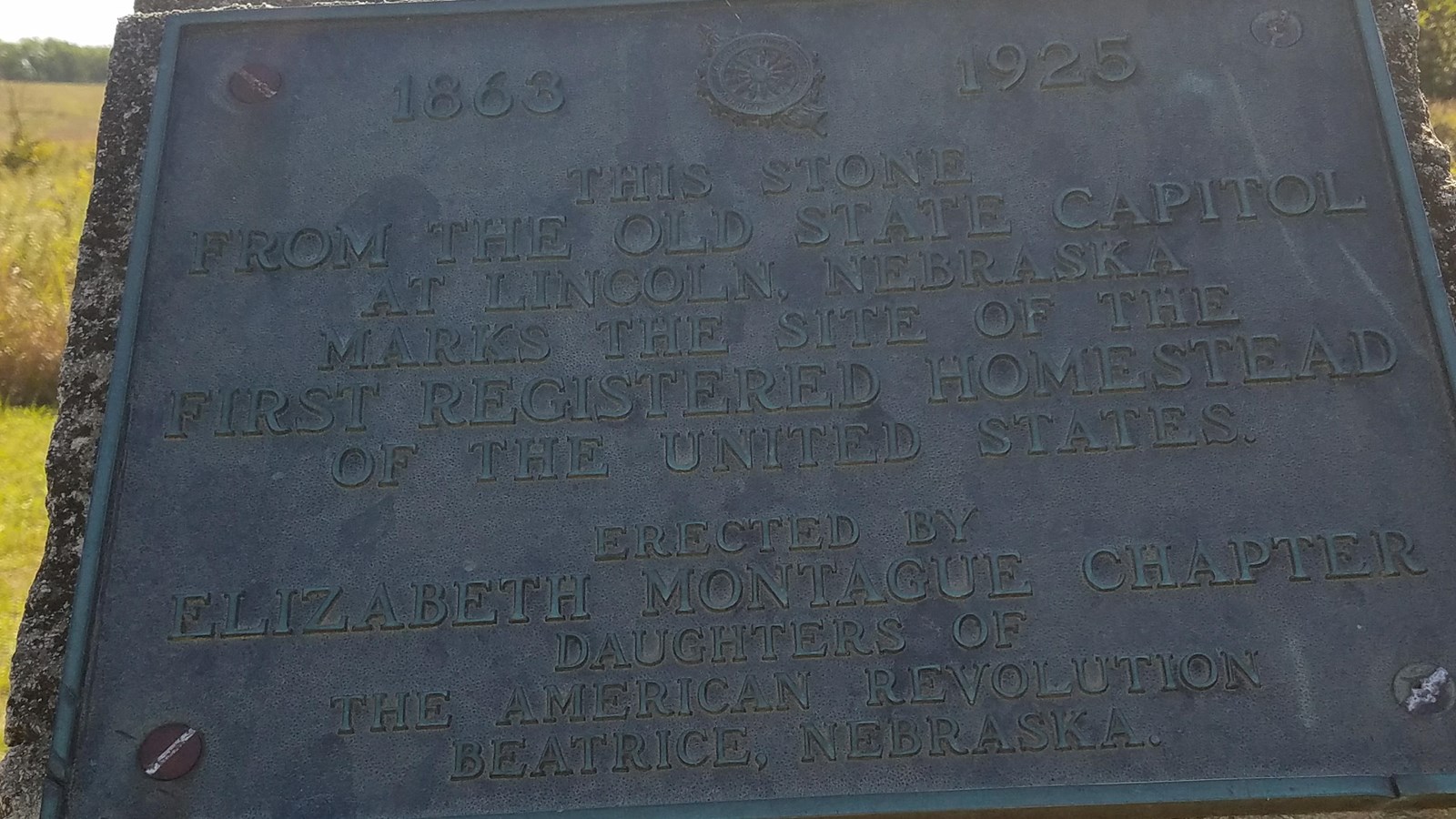Last updated: September 13, 2024
Place
Daughters of the American Revolution Monument

NPS Photo/ Amy Neumann
The Daughters of the American Revolution (DAR) created the first physical monument of Daniel Freeman's land. Attempts at creating a national monument on Daniel Freeman's homestead claim had failed and the DAR chapter in Beatrice, Nebraska wanted to help preserve the story of homesteading. In 1925 the DAR placed a stone monument on Daniel Freeman’s plot of land commemorating it as the first homestead filed under the Homestead Act of 1862.
The monument is a limestone block from the second Nebraska state capitol building with a plaque placed on top. The plaque reads: 1863-1925. This stone from the old state capital at Lincoln, Nebraska marks the site of the first registered homestead of the United States. Erected by Elizabeth Montague Chapter, Daughters of the American Revolution, Beatrice, Nebraska.
Daniel Freeman appears to have been promoting the idea of placing a monument on his farm at Beatrice as early as 1884. He wanted to memorialize it as the nation's first homestead. In late 1908 shortly after Freeman's death, people in Beatrice created a movement to preserve his homestead as a National Park. In an editorial, the Beatrice Daily Sun gave its endorsement to the proposal:
A movement started by J. E. Lang is on foot to appeal to congress to covert the old Daniel Freeman homestead into a national park. The idea has merits galore and is of more than merely local significance.
Application will be made to the Nebraska congressional representatives with a view to having a bill introduced providing for this disposition of the first homestead filed on under the law which has since made it possible for thousands to become thrifty and independent landholders. - Beatrice Daily Sun, February 12, 1909
In February 1909, Congressman Edward H. Hinshaw introduced a bill (H. R. 28380) proposing the establishment of a National Park on the Freeman homestead. Hinshaw's bill appears to have received little or no organized support. It was referred to the Committee on Public Lands and was not revived. Hinshaw renewed his attempts to preserve the Freeman homestead. On April 8. 1910 he introduced a bill (H. R. 6757), similar to H. R. 28380, to appropriate money to buy the Freeman homestead as a National Park. This bill also was referred to the Committee on Public Lands.
This time, Nebraska Governor Chester A. Aldrich asked the State Senate to give its support to Hinshaw's bill. He wrote, "[it] would be a fitting commemoration for the Services of the Honorable Galusha A. Grow."
The State Senate petitioned the Secretary of the Interior and Congress urging the passage of the Homestead Bill. The Chairman of the Committee of Public Lands and Secretary of the Interior stated that it was a policy "that national parks shall not be established except in extraordinary cases of beauty, freaks of nature, geysers, etc." The bill was not submitted for reconsideration.
In 1925, Senator George W. Norris endorsed the idea of creating a museum to house agricultural implements, representing developments from the early days at the Freeman homestead in the Nebraska State Journal.
In November, the Daughters of the American Revolution chapter in Beatrice decided to erect a monument. They went to Lincoln to select a stone to mark the site of the Freeman homestead. This marker was dedicated by Governor Adam McMullen in May 1926.
Homestead National Historical Park was finally established on March 19, 1936 (it was then called Homestead National Monument of America).
Check out this monument on the Grain Grower Highway trail at Homestead National Historical Park. Learn more about the hiking trails at the park.
